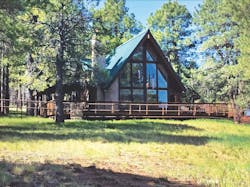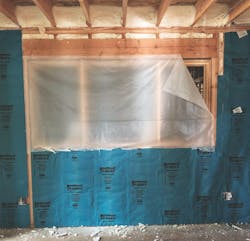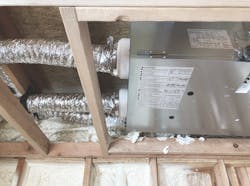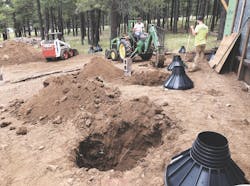Double or Nothing: Model ReModel West
Welcome to the 2019 Model ReModel. This is the fifth installment of Pro Remodeler's annual event, which follows a home remodel from demo to the final construction clean. Due to the ongoing success of the program, we doubled down this year and are covering two projects instead of one. Our real-time coverage of these exciting remodels is a great way to learn about cutting-edge products, construction techniques, and new trends in design.
The Model ReModel West project—a mountain-style home on the edge of the Coconino National Forest—is a compact but dramatic A-frame with three bedrooms. This home will gain needed space in three directions while preserving spectacular views: north to Humphreys Peak, site of the Arizona Snowbowl ski resort; west to the meadows; and east to the forest.
There are three areas of special focus for this year's West project:
Fire-conscious construction: The home sits on the edge of a pine forest. The conifers are most flammable in spring
and fall.
Aging in place: This will future-proof the home for the owners, who are in their 60s.
Energy efficiency: The remodeler is shooting for a goal of Net-Zero.
Driving the project is Bill Owens, president of Owens Construction in Columbus, Ohio. Owens might have made his name in Ohio, but has made the decision to move his expertise to Arizona.
We hope you'll come away from this profile with strategies to help save time, money, and energy on your own projects.
The project features Navien's tankless water heating system. Owens says he and his team were interested in finding one of the top performers when it came to tankless water heaters, and when they visited the EnergyStart website, Navien's NPE was a top pick. "We can cascade up to 16 units; we can take a half-inch gas line up to 24 feet; and we can run 2-inch PVC venting up to 60 feet," Owens says. "The internal recirculating pump and buffer system that you can find on this unit is another one of our favorites. The internal heat exchanger has one of the longest warranties in the business, at 15 years."
The Navien NPE is a universal unit—it can be used indoors or out—which was very attractive to the Flagstaff team, and is useful for any home on the market. "We'll be looking to do more of these as time goes on, and use Navien as a partner," says Owens. "I think this is really worth looking into for anyone who's building a high-performance, energy efficient home." The company also provides extensive field support, webinars, and training events for contractors.
In a city that sees more chilly days than scorchers, insulation is key. Owens' crew sprayed 3 inches of closed cell foam, leaving about a ½-inch of air space. (This sandwich of exterior and interior foam is good for a rating of R-30.) The inside was then covered with Fi-Foil Company's HY-Fi, an insulation system with a reflective barrier that reduces heat flow by radiation and convection (this adds to the overall R-value). HY-Fi will also cover the bottom of the rafters prior to drywall.
Bill Owens chose Panasonic Energy Recovery ventilators (air to air heat exchangers). Model FV-10VEC1 has two adjustable 50-100 cfm DC fans, and a MERV 8 filter. The ventilators are in the attic, laundry, and crawlspace. They have an override that senses when humidity levels rise, such as after a long shower. That way, humid air is exhausted and warmed, dry air brought in. The units have a a baffle system where the incoming and outgoing air pass by each other and transfer the outgoing air’s heat energy to the incoming air.
The project required massive restructuring and bracing of the original framing. Where there was once not a hanger to be found, there are now MiTek hangers at every member connecting joists to beams. From foundation to ridge, MiTek connectors ensure a home is optimized to be safe and code compliant. The beams are much stronger, too, as they were constructed out of engineered lumber, and laminated and bolted together.
Bill Owens is a great believer in the belt-and-suspenders approach to framing, and part of that approach means that he uses Titebond Construction Adhesive between the microlam headers before nailing them together to ensure they act as one under load.
“I’m glad that glues came into homebuilding about the same time I did," Owens says. "I’ve had to fix so many homes from the '60s and before that because of wall-to-wall floor squeaks."
The deck wraps around three sides of the home, and requires 23 piers. Bill Owens chose pier footing forms from Bigfoot Systems to prevent uplift from frost or wind loads. “This is way better than forming footings first and pouring piers on top of them,” says Owens.
To install, just overdig slightly. The workers were able to get the excavation clean and set the bases on a perfectly level surface, ready for the cardboard tube forms to sit on top. Another benefit of Bigfoot: If you have small-diameter piers, you can use an inverted form as a funnel when pouring concrete.







